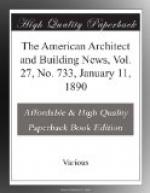That entombment can be made sanitary is evident from the fact that in countless instances, in many lands and through long periods of time, it has been made sanitary by the ingenuity of man or by unassisted nature; and it is also evident from the fact that decomposition and disease germs are the dangers to be guarded against, and that against these both ancient and modern science have been able to guard. Not to enumerate all the modes that have been chanced upon or that have been devised by men, there are two that have been notable and are available for modern use—embalming and desiccation.
It is a delusion to imagine that embalming is a lost art; that, like some other marvels of the ancient time, this is a secret process that perished with the people who employed it. Did we desire it, we could embalm our princes and our priests, and retain their shrunken similitudes for distant coming times to gaze and gape upon, as skilfully as they who practised this art in Egypt’s palmiest days. Nay, it is doubtless far within the truth to claim that better than they did we could do; and we are actually apprised of better methods and results than they employed or could attain, and it is not unlikely that we shall hear of better methods still. But Egypt’s method, or its modern counterpart, will hardly now be popular. It involves too much mutilation and too much transformation. When it has done its work little is left but bone and muscular tissue, and these are so transfused with foreign substances that a form moulded from plastic matter or sculptured from stone could almost as truly be considered that of the lamented dead as this. Moreover, indefinite preservation of the dead is not desirable, and is not desired. The uses to which the Egyptian Pharaohs and their humbler subjects have been put in these days of indelicacy and unscrupulousness in the pursuit of science or sordid gain are not such as to make many eager to be preserved for a similar disposition when the present shall have become a similarly distant past.
Desiccation, in striking contrast with embalming, is the process of nature rather than of art, and involves no mutilation and no substitution of foreign substances for human flesh, and does not by unnatural means preserve the semblance of the human form so long that a susceptible sentiment is shocked and a due return of material humanity to the elements that gave it birth prevented. Desiccation is so far a natural process that it seems not to have been thought of until nature had done the work and shown the product, and through many centuries, and upon an extensive scale, nature had employed the process before it occurred to man to copy her and adopt her method for the disposition of his dead.




